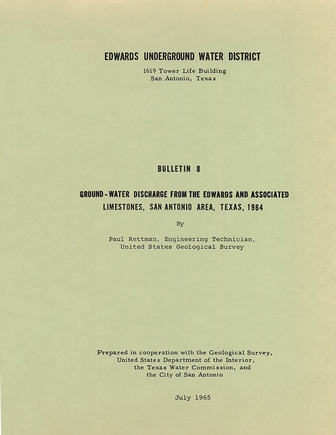Ground-Water Discharge from the Edwards and Associated Limestones, San Antonio Area, Texas, 1964

| Author | Rettman P (US Geological Survey) |
| Year | 1965 |
| Description | Annual report for 1964 on discharge from the Edwards Aquifer issued by the Edwards Underground Water District |
| Report Number | Bulletin 8 |
| Publisher | Edwards Underground Water District |
| Location | Edwards Aquifer Balcones Fault Zone San Antonio Segment |
| Cover | View Download |
| File | View Download |
| Summary |
|
Records of the ground-water discharge from the Lower Cretaceous Edwards and associated limestones in the San Antonio area are collected yearly as part of the overall hydrologic investigation by the U. S. Geological Survey in cooperation with the Edwards Underground Water District, the Texas Water Commission, and the city of San Antonio. The investigation has continued for many years and has resulted in several geologic and hydrologic reports, some of which are listed in the references. This basic-data report is one of three of its type published annually by the Edwards Underground Water District. The total 1964 discharge from the Edwards and associated limestones in each county in the area is presented in… [a] table. The discharge by springs came from five sources: San Marcos Springs in Hays County, Comal Springs in Comal County, San Antonio and San Pedro Springs in Bexar County, and the Leona River Springs in Uvalde County. On the other hand, most of the discharge from wells originated in Bexar, Uvalde and Medina Counties. The wells in Bexar County not only provided most of the discharge used for municipal and military purposes but, together with the wells in Uvalde and Medina Counties, also met the irrigation needs of over 40,000 acres in the combined area. Most of the remaining discharge–which served industrial, domestic, stock, and miscellaneous uses–was likewise from Bexar County. About 55 percent of the total discharge from the Edwards and associated limestones came from wells, and 77 percent of this discharge was from wells in Bexar County. Because the well discharge was slightly less than in the preceding year and because the springflow also decreased, the combined well and spring discharge for 1964 was about 41,000 acre-feet less than in 1963. |
Search for Documents
Advance Search
Explore EAA's Scientific Reports
- All Reports
- RZ Protection
- Aquifer Levels
- Remote Sensing
- Precipitation
- Overview Studies
- Modeling
- Hydrology and Hydrogeology
- History
- Groundwater Recharge, Recharge Zone
- Groundwater Movement
- Geomorphology and Caves
- Weather Modification
- Geology
- Water Use and Conservation
- Geochemistry
- Water Resources Planning and Management
- Floods and Drought
- Water Quality
- Climatology
- Surface Water / Groundwater Relationship
- Biology
- Springs, Groundwater Discharge
- Archaeology
